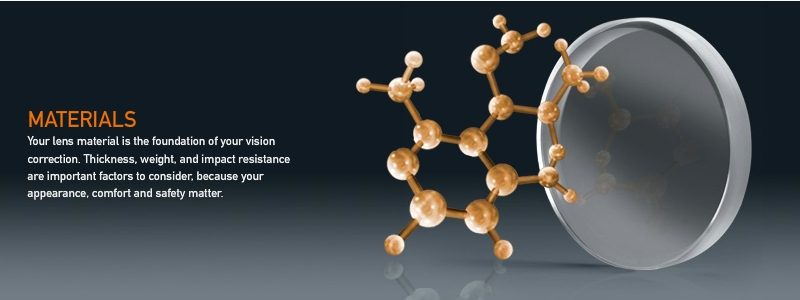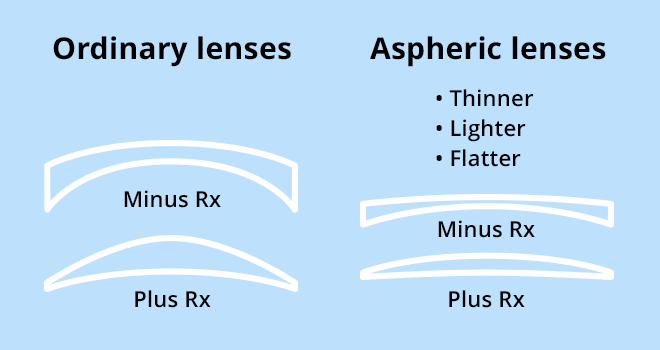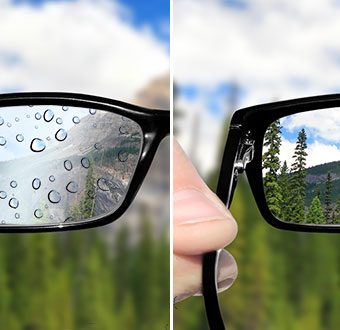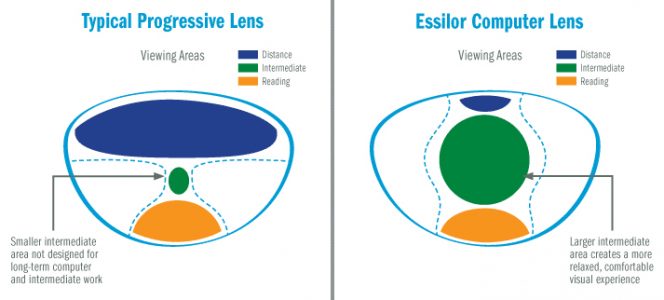We all love picking out frames (well most of us) because it’s the most fun part of the whole process. Where things get confusing and where customers often get taken advantage of is the lens selection. Optics is a whole different technical language and one that the everyday person probably doesn’t understand. There are so many different details you can change about a lens that a sales person can bust out some fancy jargon and convince you to spend more money than you really need to. Hopefully this blog will help you learn a little more about the lens selection process and what you need to know to make the right choice for you.
It all starts with the prescription. Everyone’s is different and unique to only themselves (some people may happen to be the same but it’s quite rare). If you understand your prescription, then you’ll be able to decide what you do and don’t need for your lenses. It also helps to know when and where you’ll be wearing the glasses – ie. do you need them for fly-fishing or more for the computer (two completely different requirements). If you’re not sure what your prescription means, STOP and click to learn about that first.

We’ll start with lens materials:
- plastic: most common material for glasses and used for everyday requirements
- glass: very uncommon and only some labs will still offer it (only individuals with ridiculously high prescription would need glass)
- polycarbonate: used for safety glasses due to it’s durability properties (optics are slightly compromised)
There are some other materials, but the above listed are what most people will know/ask about. Within the plastic and glass materials, there are different indices available which change the thickness of the lens. Only people with higher prescriptions need to consider this to ensure their glasses are not too thick and heavy.
- light prescriptions: 1.50 index is fine and the most affordable
- moderate prescriptions: 1.60 index is highly advised to reduce the thickness and the weight of the lens by approximately 30% thinner than the same prescription in a 1.50 index
- high prescriptions: 1.67 index would be the best choice to again reduce the thickness and weight (this time by 45%)
- very high prescriptions: 1.74 index is required so that the lens stays in the frame (thickness and weight reduced by 55%)

Aspheric lenses are highly recommended for people with moderate to high astigmatism to reduce the amount of distortion seen through the lens around the edges. Aspheric lenses are made with flatter curves than conventional lenses so that one side of the lens is flatter than the other to cut out aberrations and distortions. It also improves the profile of the lens so it doesn’t appear bulged on one side.
 There are many different types of coatings to choose from. Personally, I have not tried every single brand on the market so I cannot speak to which brand is better. All manufacturers have their own version of high quality coatings. The choice should stem from how often you wear your glasses and what you wear your glasses for. If you’re like me and wear your glasses almost everyday, investing in a higher quality coating that repels dirt, dust, and oil, is easier to clean, resists smudges, is scratch-resistant, and has anti-glare is worth it. It makes the glasses so much easier to care for and ensures the lenses last longer. Now if you don’t wear them all the time, maybe just for reading or only when you get home from work, then maybe you don’t need such a fancy coating (it’s completely up to you and if you want those convenience factors or not). For computer users (3+ hours/day), having a blue-blocking coating would be highly recommended at our office. This is to protect your eyes from the harmful blue light that is emitted from devices (computer screens, TVs, laptops, phones, tablets, etc.).
There are many different types of coatings to choose from. Personally, I have not tried every single brand on the market so I cannot speak to which brand is better. All manufacturers have their own version of high quality coatings. The choice should stem from how often you wear your glasses and what you wear your glasses for. If you’re like me and wear your glasses almost everyday, investing in a higher quality coating that repels dirt, dust, and oil, is easier to clean, resists smudges, is scratch-resistant, and has anti-glare is worth it. It makes the glasses so much easier to care for and ensures the lenses last longer. Now if you don’t wear them all the time, maybe just for reading or only when you get home from work, then maybe you don’t need such a fancy coating (it’s completely up to you and if you want those convenience factors or not). For computer users (3+ hours/day), having a blue-blocking coating would be highly recommended at our office. This is to protect your eyes from the harmful blue light that is emitted from devices (computer screens, TVs, laptops, phones, tablets, etc.).

Polarized? Transitions? These two choices are for those people getting prescription sunglasses. Polarized lenses are great for people who are bothered by glare. Whether it be someone who spends a lot of time on the water, is bothered by glare while driving, or is into outdoor sports, this is a great option to have. Polarized lenses contain a specialized filter that cuts the wavelength of light that causes glare – having this makes it difficult to use your phone though (or devices in general). Transitions on the other hand, are lenses that are treated with a special coating that darkens with UV exposure. So if you’re looking for an all-in-one pair of glasses, this might be something to consider. You can choose between grey, brown, or green (new colour for select lenses). This is great for individuals who are on the go a lot and go from indoors to outdoors frequently. Or if you just don’t want multiple pairs of glasses. But for optimal UV protection this is not the best option.
Digital or conventional? Digitally surfaced lenses are lenses where a computer inputs your prescription across more points across the lens. This is optimal for individuals with high prescriptions and high astigmatism. Ultimately, digital lenses will reduce distortions the most (in addition to being aspheric). These are great lenses – almost magical I would say. When I got my first pair of Nikon SeeMax lenses I was amazed with my vision. I thought I was seeing clearly before but when I got those lenses, every mm of my vision through the lenses was clear. For people that are bothered by distortion through their lens (even with aspheric ones), this would be the next step.
Single vision lenses just mean one prescription and one prescription only. For most people, this is what you would need unless you’ve reached the ripe age where you start to need reading glasses. These are also great for task-specific lenses, because sometimes the “all-in-ones” aren’t the best for long term work at a set distance.

Progressives are lenses that incorporate more than one prescription into the lens so that the glasses can be used for easy everyday life. I have not reached the point in my life where I require progressives so I cannot speak about them from personal experience. What a progressive is, is a lens that provides clear vision for your distance all the way through to your reading. For this to happen, the vision through the sides of the lenses if often distorted. Progressives are good for everyday use, but for people that work all day on a computer, I would not recommend these because the “computer area” can be quite small or narrow. This small area makes it difficult to use and often isn’t lined up with where our monitors are and you may end up with neck/back pain trying to adjust your head to look through the right area. Within the lens family of progressives, there are a lot of choices from conventional to digital. The price differs depending on how technologically advanced the lenses are (the more advanced and digital, the more expensive). It depends on how much the distortion bothers you. If you cannot stand it, then you’ll have to spend the money to reduce the distortion OR simply switch to having separate distance and reading glasses (bifocals are available but rather archaic). If you aren’t too bothered by the distortion and have adapted to looking through just the clear zones and ignoring the distorted zones, you may not need to spend as much but progressives are generally going to be the most expensive lenses.
Therapeutic and anti-fatigue lenses are for people that spend a lot of time on devices and over-work their eye muscles. Depending on the brand, different areas of the lens will be “relaxing zones” and put in at the bottom of the lens for when we look at computers or devices to help reduce the strain on our eyes. These are newer lenses and a new niche of lenses. I myself where the Nikon RelaxSee lenses and find that my eyes are less tired after days where I spend a lot of time on a computer. Therapeutics are great because I maintain my clear distance vision while still having a slight prescription for when I do computer or device related work. There was a small adaptation period, but after a couple of hours I was fine. Nikon, Essilor, Zeiss, and Hoya all make their own version of these lenses (we supply all of these at Wink!) – depending on your work, one may work better than the other.

Computer lenses are also newer lenses on the market for the niche of people that work in an office environment (which is a vast majority now-a-day). They specifically widen the zones for computer and near vision. They’re like a progressive but not – more like a task-specific progressive. There are still changes in the lens but your vision is optimized for being in an office environment where your distance vision is not as important.
In addition to all these choices, you can combine a number of them so don’t be afraid to ask your optician and see if it’s possible.
This was a long one! But I hope an educational one because that is what we aim to do at Wink. We want our clients to make educated choices based on their needs and lifestyle. If you ever have any questions, feel free to drop by and visit us in Burnaby and we will be happy to give you advice.


Good day! I just want to offer you a big thumbs up for
the excellent info you’ve got here on this post.
I will be returning to your web site for more soon.
I do consider all of the ideas you have introduced
in your post. They’re really convincing and will certainly work.
Nonetheless, the posts are too quick for starters.
May just you please extend them a little from next time?
Thank you for the post.